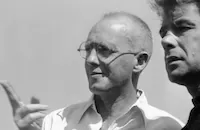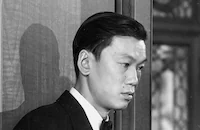Submarine Command
Brief Synopsis
Cast & Crew
John Farrow
William Holden
Nancy Olson
William Bendix
Don Taylor
Arthur Franz
Film Details
Technical Specs

Synopsis
While wandering through a mothballed Navy submarine, the U.S.S. Tiger Shark , Commander Ken White recalls the day he became the submarine's last captain: On 13 Aug 1945, in the waters of the Pacific war zone, Ken and the outgoing commander of the Tiger Shark , Josh Rice, are discussing the probable surrender of the Japanese when a downed Navy pilot is spotted. After the pilot, Lt. Commander Peter Morris, is rescued, the submarine encounters some Japanese ships and prepares to attack. Josh allows Ken, an Academy graduate with no combat experience, to issue orders, and under Ken's directions, the Tiger Shark cripples the Japanese vessels. When the submarine surfaces, however, a Japanese plane strafes the deck, and Josh is shot. The Tiger Shark then is hit by a Japanese destroyer, and to save the ship, Ken orders the submarine to crash dive, ignoring the protests of C. P. O. Boyer, who wants to rescue the stranded Josh. Soon after, Ken learns that the Japanese have surrendered and returns to pick up Josh. Josh cannot be found, however, and when the Tiger Shark later docks in California, a guilt-ridden Ken visits Josh's wife Alice and his father, Rear Admiral Joshua Rice. Although Alice and Joshua reassure Ken that he was right to put the safety of the ship first, Ken continues to be haunted by Josh's death. That night, Ken, his longtime girl friend Carol and the hard-drinking playboy Pete, whom Ken had befriended on the Tiger Shark , dine together at a nightclub. Despite his lingering depression, Ken accepts Carol's marriage proposal, and the couple announces their engagement. Years later, Ken, who has been assigned to a desk job, is asked to escort a reporter around the base's mothballed submarine fleet, and is disturbed when the visitor makes a derogatory comment about the Tiger Shark 's last captain. Ken's guilt resurfaces, especially after he learns that the submarine is being recommissioned for service in the Korean War and he is to command it. During the vessel's reconditioning, a sailor is killed in a boiler room accident, and Boyer, who also has been reassigned to the Tiger Shark , once again blames Ken. Ken grows more and more depressed until Carol finally suggests that he quit the Navy. Ken then receives a job offer from a Portland electrical company, which Carol secretly has arranged, but just as he is about to resign from the Navy, he changes his mind, declaring that he cannot run away from his problems. Carol, however, is fed up and moves out. Soon after, Ken and the Tiger Shark are sailing toward North Korea to undertake a secret mission. On the way, Ken receives a letter from Carol, who is cordial but distant. Later, when Ken meets up with Pete on an aircraft carrier, he questions him about Carol's feelings, but Pete is evasive. Ken and Pete then are briefed on their mission, which involves destroying an air radar station in Point Nokomo and a telephone center in Koyasan, so that paratroopers can land and liberate intelligence officers from a prisoner of war camp. That night, while Ken remains on board, Pete and South Korean officer Maj. Kim slip into the Point Nokomo harbor on a raft, overpower the North Korean guards and plant explosives outside the radar station. Before the bombs go off, the Tiger Shark hurries to the mine-filled port of Nokomo and releases two frogmen, who plant explosives at the telephone center. Once Ken receives signals from Pete and the frogmen, the bombs are set off, and Ken orders the submarine to surface and sends an all-clear to his superiors. The Tiger Shark is spotted and attacked by North Korean shore batteries. After the submarine suffers severe damage, Ken instructs his crew to abandon ship, and while the men are clinging to life preservers, Boyer forgives Ken. Pete then tells Ken that Carol is pregnant, and months later, a reunited Ken and Carol happily christen a new Tiger Shark , as their baby looks on.

Director

John Farrow
Cast

William Holden

Nancy Olson

William Bendix

Don Taylor

Arthur Franz

Darryl Hickman
Peggy Webber

Moroni Olsen
Jack Gregson

Jack Kelly
Don Dunning

Jerry Paris
Charles Meredith
Philip Van Zandt
Gordon Polk

Walter Reed

Noel Neill
Fred Zendar
John Close
Leslye Banning

Benson Fong
Paul Lees
Steve Pendleton
William H. Mclean
George Wallace
Joey Ray
Richard Berggren
John Mallory
Don House
James Cornell
Mark Lowell
Marietta Elliott
Freeman Lusk
Warren Mace
Harold Fong
Rollin R. Moriyama
Frank Iwanaga
Don Shelton
Robert Tidwell
Crane Whitley
Mike Mahoney
Nelson Leigh
George L. Little
Rear Admiral Thomas M. Dykers Usn (ret)
Harry Mendoza
Jack Roberts
Gwen Caldwell
Jerry James
Crew
Ralph Axness
Harry Barndollar
Henry Bumstead
David Buttolph
Herb Coleman
Sam Comer
Ross Dowd
Rear Admiral Thomas M. Dykers Usn (ret)
Farciot Edouart
Gene Garvin
Edith Head
Gordon Jennings
Clem Jones
Jonathan Latimer
Harry Lindgren
Lionel Lindon
Hal Pereira
Don Robb
Joseph Sistrom
Eda Warren
Wally Westmore

Videos
Movie Clip



Film Details
Technical Specs

Articles
Submarine Command -
In Submarine Command (1951), Holden is joined for the fourth and final time by his frequent co-star Nancy Olson, playing his long-suffering wife. The two were most memorably cast together as ill-fated lovers in Sunset Boulevard (1950).
The working title of the film was "The Submarine Story." According to news items and Paramount publicity materials, the picture was originally set to star Alan Ladd, with John Lund taking on the role eventually played by Don Taylor. Holden and Taylor became good friends and drinking buddies on the set (in fact, Holden later said he remembered so little about filming Submarine Command because he was drunk the entire time). Their antics caused some consternation for director John Farrow (husband of Maureen O'Sullivan and father of future actress Mia Farrow). Holden said the only thing about the shoot he remembered was when he and Taylor jumped off a ship and swam to the submarine instead of allowing their doubles to do it as required, a "joke" on Farrow that the director did not appreciate, especially since as the uncredited executive producer he was essentially the money man behind the production as well.
Holden and Taylor also wandered down to the set of a South Seas picture starring their mutual pal Ronald Reagan. Dressed in the Navy uniforms, the two turned up in a crowd scene. The assistant director told them their inadvertent appearance required them to be paid extra checks and asked Holden if he wanted his sent to charity. "Yes," Holden reportedly answered, "my favorite charity-Bill Holden."
Location shooting on Submarine Command took place in and around San Diego and the Mare Island Navy Base in Vallejo, California. The aircraft carrier used in the film, the USS Boxer, never received any major modernization and retained the classic appearance of a World War II Essex-class aircraft carrier ship during its 24-year career (1945-1969). In 1948, the ship was the site of the first landing of a Navy jet aircraft aboard a carrier. The Boxer was also scheduled to be the prime recovery vessel for the Gemini 8 mission in March 1966 but missed the opportunity when the space flight had to make an emergency landing in the Western Pacific.
Holden recreated his role in Submarine Command for a November 1952 Lux Radio Theatre version of the story. Alexis Smith took on Olson's role as his wife for that broadcast.
Director: John Farrow
Producer: Joseph Sistrom
Screenplay: Jonathan Latimer
Cinematography: Lionel Lindon
Editing: Eda Warren
Art Direction: Henry Bumstead, Hal Pereira
Original Music: David Buttolph
Cast: William Holden (Lt. Cmdr. Ken White), Nancy Olson (Carol), William Bendix (CPO Boyer), Don Taylor (Lt. Cmdr. Peter Morris), Arthur Franz (Lt. Carlson).
BW-87m.
by Rob Nixon

Submarine Command -
Quotes
Trivia
Notes
The working title of this film was The Submarine Story. Opening credits include the following written acknowledgment: "This picture was photographed almost in its entirety aboard United States Naval vessels and in Naval shore installations. For making this possible, we gratefully acknowledge the cooperation of the United States Navy and the Department of Defense without which the picture could not have been made." The film opens with a brief voice-over narration describing the U.S. Navy's mothballed submarine fleet. Voice-over narration spoken by William Holden as his character "Commander Ken White" then is heard intermittently throughout the film.
According to news items and Paramount publicity materials, contained in the file on the film at the AMPAS Library, Alan Ladd and John Lund were originally slated to star in the picture. Clint Dorrington, Fred Stephens and John Martin were announced as cast members in Hollywood Reporter news items, but their appearance in the final film has not been confirmed. Hollywood Reporter news items note that location shooting took place in and around San Diego and the Mare Island Navy Base in Vallejo, CA. During World War II, Rear Admiral Thomas M. Dykers, who worked as a technical advisor and appeared in a small role in the film, commanded the U.S.S. Jack submarine and sank four Japanese tankers in a twenty-four hour period, according to Paramount publicity materials. Holden and Nancy Olson had previously appeared together in Paramount's 1950 film Sunset Blvd. and Force of Arms (see AFI Catalog of Feature Films, 1941-50). Holden recreated his "Commander White" role for a November 17, 1952 Lux Radio Theatre version of the story, which co-starred Alexis Smith.














